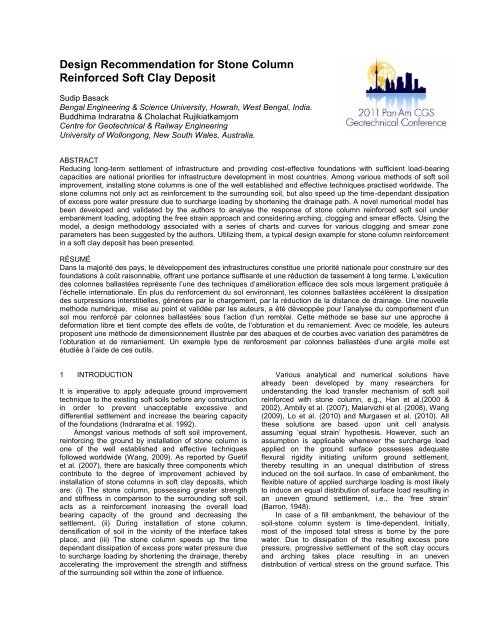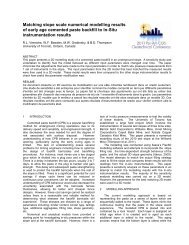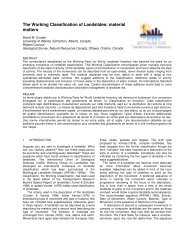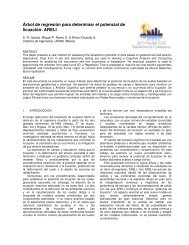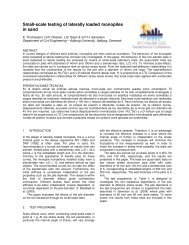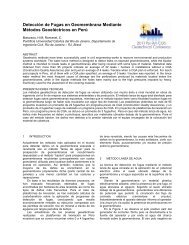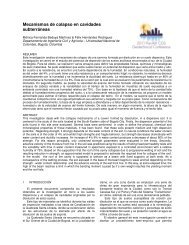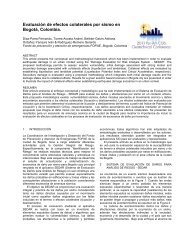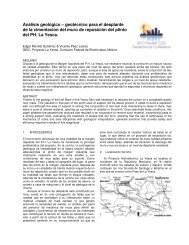Design Recommendation for Stone Column Reinforced Soft Clay ...
Design Recommendation for Stone Column Reinforced Soft Clay ...
Design Recommendation for Stone Column Reinforced Soft Clay ...
Create successful ePaper yourself
Turn your PDF publications into a flip-book with our unique Google optimized e-Paper software.
<strong>Design</strong> <strong>Recommendation</strong> <strong>for</strong> <strong>Stone</strong> <strong>Column</strong><br />
Rein<strong>for</strong>ced <strong>Soft</strong> <strong>Clay</strong> Deposit<br />
Sudip Basack<br />
Bengal Engineering & Science University, Howrah, West Bengal, India.<br />
Buddhima Indraratna & Cholachat Rujikiatkamjorn<br />
Centre <strong>for</strong> Geotechnical & Railway Engineering<br />
University of Wollongong, New South Wales, Australia.<br />
ABSTRACT<br />
Reducing long-term settlement of infrastructure and providing cost-effective foundations with sufficient load-bearing<br />
capacities are national priorities <strong>for</strong> infrastructure development in most countries. Among various methods of soft soil<br />
improvement, installing stone columns is one of the well established and effective techniques practised worldwide. The<br />
stone columns not only act as rein<strong>for</strong>cement to the surrounding soil, but also speed up the time-dependant dissipation<br />
of excess pore water pressure due to surcharge loading by shortening the drainage path. A novel numerical model has<br />
been developed and validated by the authors to analyse the response of stone column rein<strong>for</strong>ced soft soil under<br />
embankment loading, adopting the free strain approach and considering arching, clogging and smear effects. Using the<br />
model, a design methodology associated with a series of charts and curves <strong>for</strong> various clogging and smear zone<br />
parameters has been suggested by the authors. Utilizing them, a typical design example <strong>for</strong> stone column rein<strong>for</strong>cement<br />
in a soft clay deposit has been presented.<br />
RÉSUMÉ<br />
Dans la majorité des pays, le développement des infrastructures constitue une priorité nationale pour construire sur des<br />
foundations à coût raisonnable, offrant une portance suffisante et une réduction de tassement à long terme. L‟exécution<br />
des colonnes ballastées représente l‟une des techniques d‟amélioration efficace des sols mous largement pratiquée à<br />
l‟échelle internationale. En plus du ren<strong>for</strong>cement du sol environnant, les colonnes ballastées accélèrent la dissipation<br />
des surpressions interstitielles, générées par le chargement, par la réduction de la distance de drainage. Une nouvelle<br />
methode numérique, mise au point et validée par les auteurs, a été déveoppée pour l‟analyse du comportement d‟un<br />
sol mou ren<strong>for</strong>cé par colonnes ballastées sous l‟action d‟un remblai. Cette méthode se base sur une approche à<br />
de<strong>for</strong>mation libre et tient compte des effets de voûte, de l‟obturation et du remaniement. Avec ce modèle, les auteurs<br />
proposent une méthode de dimensionnement illustrée par des abaques et de courbes avec variation des paramètres de<br />
l‟obturation et de remaniement. Un exemple type de ren<strong>for</strong>cement par colonnes ballastées d‟une argile molle est<br />
étudiée à l‟aide de ces outils.<br />
1 INTRODUCTION<br />
It is imperative to apply adequate ground improvement<br />
technique to the existing soft soils be<strong>for</strong>e any construction<br />
in order to prevent unacceptable excessive and<br />
differential settlement and increase the bearing capacity<br />
of the foundations (Indraratna et al. 1992).<br />
Amongst various methods of soft soil improvement,<br />
rein<strong>for</strong>cing the ground by installation of stone column is<br />
one of the well established and effective techniques<br />
followed worldwide (Wang, 2009). As reported by Guetif<br />
et al. (2007), there are basically three components which<br />
contribute to the degree of improvement achieved by<br />
installation of stone columns in soft clay deposits, which<br />
are: (i) The stone column, possessing greater strength<br />
and stiffness in comparison to the surrounding soft soil,<br />
acts as a rein<strong>for</strong>cement increasing the overall load<br />
bearing capacity of the ground and decreasing the<br />
settlement, (ii) During installation of stone column,<br />
densification of soil in the vicinity of the interface takes<br />
place, and (iii) The stone column speeds up the time<br />
dependant dissipation of excess pore water pressure due<br />
to surcharge loading by shortening the drainage, thereby<br />
accelerating the improvement the strength and stiffness<br />
of the surrounding soil within the zone of influence.<br />
Various analytical and numerical solutions have<br />
already been developed by many researchers <strong>for</strong><br />
understanding the load transfer mechanism of soft soil<br />
rein<strong>for</strong>ced with stone column, e.g., Han et al.(2000 &<br />
2002), Ambily et al. (2007), Malarvizhi et al. (2008), Wang<br />
(2009), Lo et al. (2010) and Murgasen et al. (2010). All<br />
these solutions are based upon unit cell analysis<br />
assuming „equal strain‟ hypothesis. However, such an<br />
assumption is applicable whenever the surcharge load<br />
applied on the ground surface possesses adequate<br />
flexural rigidity initiating uni<strong>for</strong>m ground settlement,<br />
thereby resulting in an unequal distribution of stress<br />
induced on the soil surface. In case of embankment, the<br />
flexible nature of applied surcharge loading is most likely<br />
to induce an equal distribution of surface load resulting in<br />
an uneven ground settlement, i.e., the „free strain‟<br />
(Barron, 1948).<br />
In case of a fill embankment, the behaviour of the<br />
soil-stone column system is time-dependent. Initially,<br />
most of the imposed total stress is borne by the pore<br />
water. Due to dissipation of the resulting excess pore<br />
pressure, progressive settlement of the soft clay occurs<br />
and arching takes place resulting in an uneven<br />
distribution of vertical stress on the ground surface. This
phenomenon is duly supported by other researchers (Low<br />
et al., 1994, Abusharar et al., 2009 and Deb, 2010).<br />
As reported by Han et al. (2002), a smear zone is<br />
developed in the soil adjacent to the soil-column interface<br />
due to installation. Also, because of the migration of clay<br />
particles from soil into the pores of the column, a clogged<br />
zone may be <strong>for</strong>med within the column in the vicinity of<br />
the soil-column interface (Adalier et al., 2004).<br />
Based on „free strain‟ hypothesis and considering the<br />
arching, smear and the clogging effects, a numerical<br />
model (finite difference method) have already been<br />
developed and validated by the authors (Indraratna et al.,<br />
2010). Using the model, a design methodology<br />
associated with appropriate design curves has been<br />
proposed and a typical design example has been<br />
illustrated in this paper.<br />
H e<br />
Embankment<br />
the corresponding time, and thereby compute the other<br />
time-dependant variables such as the degree of<br />
Impervious rigid boundary (a) <strong>Stone</strong> column<br />
Unit cell idealization q = Q + γ e H e<br />
r<br />
H<br />
Unit cell<br />
Un (b)<br />
Z<br />
it<br />
cel (<br />
2 NUMERICAL ANALYSIS<br />
l<br />
Undisturbed<br />
b<br />
zone<br />
The details of the numerical model developed have been<br />
)<br />
described elsewhere (Indraratna et al., 2010). A brief<br />
Smear zone<br />
illustration of the analysis carried out is given herein.<br />
Clogged<br />
The analysis was done based on the assumption that<br />
r s<br />
column zone<br />
the compressive strains of the soil column occur only in<br />
the vertical direction, and ignoring the elastic settlements<br />
r e<br />
Unclogged<br />
which are insignificant compared to the consolidation<br />
column zone<br />
settlement. The soil was assumed to be fully saturated<br />
with incompressible water, the flow of water through the<br />
soil to be purely horizontal (radial towards the column)<br />
following Darcy‟s law and no flow of water to take place<br />
(c)<br />
through the cylindrical boundary and the impervious base Fig.1. (a) A typical stone column rein<strong>for</strong>ced soft clay<br />
of the unit cell. The coefficients of permeability (k h) and deposit supporting an embankment. (b) Unit cell<br />
compressibility (m v) of the soil was assumed to remain idealization. (c) Cross section of the unit cell.<br />
constant during the process of consolidation.<br />
The idealised problem is depicted in Figures 1(a) and Radial<br />
(b). The soft clay layer of thickness H has been assumed divisions:<br />
<strong>Stone</strong> column Ground surface Vertical<br />
to overlay on an impervious rigid boundary, and is<br />
improved by a group of stone columns having a radius r c<br />
divisions: 1<br />
δ z<br />
2 3 . . . . . . . . . i . . . . . . . . . n-1 n 1<br />
each, extended to the bottom of the clay layer. The<br />
2<br />
average load intensity on the ground surface ( q ), was<br />
δ z<br />
expressed as a sum of the uni<strong>for</strong>m surcharge load<br />
intensity Q on the embankment fill and the self weight of<br />
3<br />
δ r δ r<br />
.<br />
the embankment (γ eH e). The radius of influence of the<br />
.<br />
unit cell r e could be calculated following the method of<br />
δ z<br />
.<br />
Wang (2009). The cross section of the entire zone of the<br />
.<br />
unit cell was divided into four distinct zones (Fig.1c), viz.,<br />
j<br />
the unclogged column zone, clogged column zone, smear<br />
.<br />
zone adjacent to the column and the outer undisturbed<br />
.<br />
soil zone. As shown in Fig.2, the soil mass within the unit<br />
.<br />
cell had been divided both radially as well as vertically<br />
into (n-1) number of equal divisions; n being a positive<br />
.<br />
n-1<br />
integer greater than unity, such that each of such<br />
divisions may be expressed respectively as:<br />
δ r<br />
Impervious rigid boundary<br />
= (r e – r c)/(n-1) and δ z = H/(n-1). The total time interval of<br />
r e - r c<br />
n<br />
computation t t is divided into (n-1) number of equal<br />
Figure 2. Soil element discritization within the unit cell.<br />
divisions, i.e., δ t = t t /(n-1). In this paper, these separators<br />
are denoted as „nodes‟. The soil elements are<br />
blanket<br />
Q<br />
Sand<br />
understandably ring-shaped. The primary objective of the<br />
analysis was to compute the excess pore water pressures<br />
and the effective stresses developed at each separator at<br />
consolidation and settlement.<br />
Embank<br />
ment<br />
H
The smear zone parameters, viz. r s and k s may be<br />
reasonably estimated following the recommendations of<br />
Han et al. (2002), Walker et al. (2006) and Wang (2009),<br />
where, r s and k s are the radius and the horizontal<br />
permeability of soil in the smear zone respectively. The<br />
clogging effect was quantified by the non-dimensional<br />
parameters α and α k. Because of the different column to<br />
soil stiffness ratio, the soil arching beneath the<br />
embankment occurs. Following the analysis of Abusharar<br />
et al. (2009), the arching effect was analysed to compute<br />
the vertical stress distribution q(r) on the ground surface<br />
which was found to be parabolic and a unique function of<br />
N (=r e/r c), n s, r c, r, q and K p (passive earth pressure<br />
coefficient of the embankment). The term n s, referred as<br />
the stress concentration ratio, was defined as the ratio of<br />
stiffness between soft soil and stone columns and a<br />
function of height of embankment, properties of the soils<br />
in the embankment and that of the soft clay deposit. The<br />
values of n s can be reasonably estimated following the<br />
recommendations Castro et al. (2009).<br />
The nodal excess pore pressures were computed<br />
based on the radial consolidation theory of Barron (1948).<br />
Using appropriate boundary conditions, the following<br />
matrix equation was evaluated:<br />
A { u}<br />
{ b}<br />
……(1)<br />
where, A coefficient matrix; {u}<br />
unknown vector<br />
<strong>for</strong> excess pore water pressure at nodes; {b}<br />
augment<br />
vector.<br />
Solving the Equation (1), the nodal excess pore<br />
pressures, and hence the degree of consolidation, were<br />
computed. The nodal displacements within the soil mass<br />
of the unit cell at time t was given as:<br />
t z<br />
u( r,<br />
z)<br />
……(2)<br />
m<br />
v<br />
0 0<br />
t<br />
dzdt<br />
The nodal and average ground settlements were<br />
computed by carrying out numerical integration.<br />
The effective stress developed in the soil mass at any<br />
point (r, z, t) in the space-time coordinate may be<br />
expressed by (Khan et al., 2010):<br />
r , z,<br />
t z q(<br />
r)<br />
u(<br />
r,<br />
t)<br />
……(3)<br />
where, γ’ is the effective unit weight of the soil mass.<br />
During consolidation, the undrained strength and<br />
stiffness of the soil increase progressively. Guetif et al.<br />
(2007) carried out extensive finite element analysis to<br />
investigate the improved soft clay characteristics due to<br />
stone column installation. The undrained cohesion at any<br />
point in the space-time coordinate system was computed<br />
following the analysis of Umezaki et al. (1993). The<br />
increased soil strength was quantified by a nondimensional<br />
improvement factor β which was defined as<br />
the minimum value of the ratio of the post-consolidation<br />
to initial undrained cohesion at ground surface. Similarly,<br />
the increase in stiffness of the soft soil was expressed as<br />
a settlement factor ξ defined as the ratio of the average<br />
ground settlements of the rein<strong>for</strong>ced to unrein<strong>for</strong>ced soils<br />
at 90% consolidation.<br />
For design purpose, a modified time factor T’ 90 has<br />
been introduced herein, which is expressed as:<br />
T’ 90= c vr t 90 / H 2 ……(4)<br />
where, t 90 is the time required <strong>for</strong> the average degree of<br />
consolidation to attain 90% and c vr = coefficient of radial<br />
consolidation of the soil = k h / (m v γ w ), γ w being the unit<br />
weight of water. Since both r c and r e are variables, the<br />
constant parameter H is used <strong>for</strong> normalizing the time.<br />
The computation was carried out by means of a userfriendly<br />
computer software written in FORTRAN 90<br />
language. The relevant flowchart is shown in Fig.3.<br />
Start<br />
Input soil data, column parameters,<br />
imposed load and time<br />
Compute excess pore water pressures<br />
developed in the soil <strong>for</strong> all values of i and k<br />
Compute effective stresses<br />
induced in the soil <strong>for</strong> all values of r, z and t<br />
Compute nodal displacement<br />
of soil at all nodal points<br />
Compute undrained shear strength<br />
<strong>for</strong> all values of r, z and t<br />
Compute improvement factor and<br />
settlement factor <strong>for</strong> all t<br />
Print output results<br />
Stop<br />
Figure 3. Flowchart <strong>for</strong> the computer program.<br />
3 VALIDATION<br />
Comparison of the average degree of consolidation by<br />
radial drainage only has been made with the existing<br />
solutions of Barron (1948), Hansbo (1981), Han et al.<br />
(2000 & 2002) and Wang (2009). The variations of<br />
average degree of consolidation with time factor are<br />
presented in Fig.4. It was observed that the results<br />
obtained using the present model are in acceptable<br />
agreement with the other solutions and close to those of<br />
Han et al. (2002).<br />
Redana (1999) analysed the per<strong>for</strong>mance of two test<br />
embankments T1 and T2 constructed at a naval dockyard<br />
of Pom Prachul, Thailand. For improvement of soft<br />
ground, sandwitch drains were installed in a square
(a)<br />
N=2, kh/ks=10, rs/rc=1.1,<br />
H/rc=20, ns=3, α=1 Period (days) Thickness<br />
Fill<br />
Rest<br />
(m)<br />
Figure 4. Comparison of computed rates of consolidation<br />
using different methods.<br />
T1 T2 T1 T2<br />
Unit<br />
weight<br />
(kN/m 3 )<br />
0-12 0-6 12-20 6-10 0-0.35 16.2<br />
20- 10- 38-110 23-98 0.35-1.1 18<br />
38 23<br />
110-<br />
130<br />
98-<br />
121<br />
130-<br />
onward<br />
121-<br />
onward<br />
1.1-2.35 19<br />
α<br />
α<br />
grid pattern and filled with compacted dry sand. The field<br />
test results were compared with those obtained by using<br />
the model and that of Han et al. (2002). The<br />
computational parameters adopted are same as<br />
thosefound by Redana (1999) and presented in Table1.<br />
The variations of average ground settlement and excess<br />
pore water pressure with time are shown in Figures 5(a) &<br />
(b) respectively. As observed, although the timesettlement<br />
variation obtained by the present model is in<br />
reasonably good agreement with the field data, the<br />
solutions of Han et al. (2002) slightly over-predicts the<br />
values. The assumption of free strain and the parabolic<br />
distribution of vertical stress on ground surface in the<br />
present analysis have significantly affected the results. As<br />
regards to the time variation of excess pore pressure, the<br />
present solution yields promising results as compared to<br />
the field data <strong>for</strong> t > 100 days, where as the solution of<br />
Han et al. (2002) slightly under-predicts the values. For t<br />
< 100 days, both the solutions were observed to give<br />
relatively lower values compared to the field test results.<br />
Solutions are also obtained considering clogging effect (α<br />
= 0.5, α k = 1) which predicts the settlement and the<br />
excess pore water pressure even closer to the field<br />
values.<br />
4 DESIGN RECOMMENDATION<br />
Indraratna (2009) reported ground improvement at the<br />
Ballina Bypass <strong>for</strong> construction Pacific Highway linking<br />
between Sydney and Brisbane. This site had a floodplain<br />
consisting of highly compressible and saturated marine<br />
clay deposits. A soft silty layer of clay approximately 10 m<br />
thick was underlain by moderately stiff, silty layer clay<br />
located 10-30m deep, which was in turn underlain by firm<br />
clay. The groundwater level was almost at the ground<br />
surface. The relevant field data are utilized herein to<br />
carry out a hypothetical case study followed by a design<br />
illustration. The parameters used <strong>for</strong> computation in this<br />
case study are given in Table 1. Using these values, a set<br />
of typical design curves are developed. The variation<br />
Figure 5. Comparison of numerical results with field test<br />
data of Redana (1999) <strong>for</strong>: (a) settlement versus time.<br />
(b) excess pore pressure versus time.<br />
of T’ 90 with N <strong>for</strong> different values of H/r c and n s are<br />
presented in Fig.6, assuming reasonable smear and<br />
clogging parameters. Similarly, the variation of the<br />
stiffness factor ξ with N <strong>for</strong> different values of H/r c and n s<br />
are presented in Fig.7. Lastly, the variation of the<br />
improvement factor β with normalized imposed stress<br />
q/c u0 were plotted (Fig.8) <strong>for</strong> different values of N and n s ,<br />
c u0 being the initial undrained cohesion at ground surface.<br />
It has been observed that the variation of β with H/r c is<br />
insignificant, and there<strong>for</strong>e not considered.<br />
For other values of smear and clogging parameters,<br />
similar design curves can be prepared using the model<br />
and the relevant computer software developed.<br />
4.1 <strong>Design</strong> Example<br />
In this section, how the solutions developed and the<br />
above-mentioned design curves are used in actual design<br />
are described. The following are the design requirements:<br />
(i) The consolidation is expected to be completed 90 %<br />
by 1 year after the completion of the embankment<br />
construction.<br />
(b)
Improvement factor, β<br />
(ii) The height of embankment above the virgin ground<br />
level should be 4.3 m.<br />
(iii) The desired improvement factor should not be below<br />
2.75.<br />
(iv) From the serviceability criteria, the average<br />
settlement should not exceed 500 mm at 90%<br />
consolidation.<br />
Although the value of n s actually depends upon the<br />
relative stiffness of the column and the soil which should<br />
be estimated reasonably from the laboratory tests and the<br />
method of installation, it is hereby assumed as 6 (<strong>for</strong><br />
illustration).<br />
From the given data, T’ 90 = 0.00263. Using Fig.6, the<br />
value of N and H/r c can be estimated as 4 and 40<br />
respectively, from which the column parameters may be<br />
chosen as: r c = 0.5 m and r e = 2 m, although the column<br />
radius might be chosen depending upon the installation<br />
technique. The improvement factor obtained from the<br />
Fig.8 <strong>for</strong> t = 1 year is 2.926 which is well above the<br />
allowable limiting value of 2.75. Using Terzaghi‟s one<br />
dimensional consolidation theory, assuming the vertical<br />
permeability to be same as the horizontal permeability,<br />
the average surface settlement of the untreated soft<br />
ground at the end of 90% consolidation at the design<br />
embankment loading has been estimated as 4320 mm.<br />
The allowable settlement factor is there<strong>for</strong>e calculated as<br />
500/4320 = 0.116, as against the actual value of 0.11<br />
estimated from the Fig.7.<br />
T’90 (10 -<br />
1 )<br />
k s/k h =0.1; r s/r c = 1.15;<br />
α = 0.5; α k = 1;<br />
N = r e/r c<br />
Figure 6. Variation of T’ 90 with N.<br />
k s/k h = 0.1; r s/r c =<br />
1.15; α =<br />
0.5; α k = 1;<br />
n s:<br />
2<br />
6<br />
10<br />
Table 1: Input parameters <strong>for</strong> field study.<br />
Material Parameter Values<br />
Redana<br />
(1999)<br />
Indraratna<br />
(2009)<br />
k h 2 x 10 -10 1 x 10 -9 m/s<br />
m/s<br />
m v 6.13 x 10 -7 3 x 10 -6<br />
Soil<br />
m 2 /N m 2 /N<br />
k s / k h 0.1* 0.333 $<br />
r s / r c 1.15* 2.5 $<br />
H 17 m 20 m<br />
H e As reported 4.3 m<br />
γ e by Redana 20 kN/m 3<br />
Embankment Q (1999)<br />
[Given in<br />
0<br />
Fig.5(b)]<br />
K p 3 * 3 *<br />
r c 0.025m<br />
<strong>Stone</strong> column<br />
/Vertical drain<br />
r e 0.8475m<br />
(T1);<br />
1.413m<br />
(T2)<br />
To be<br />
designed<br />
n s 4.72 As given in<br />
α As given in Figures 6-8<br />
α k Fig.5<br />
* $ Assumed values ($ as per Indraratna, 2009)<br />
Figure 7. Variation of ξ with N.<br />
N: n s :<br />
6;<br />
2:<br />
2<br />
2<br />
Time = t 90<br />
k s/k h = 0.1; r s/r c = 1.15;<br />
α = 0.5; α k = 1;<br />
Normalized imposed stress, q / c u0<br />
Figure 8. Variation of β with normalized<br />
imposed load intensity.
5 CONCLUSIONS<br />
Considering the characteristics of stone column<br />
rein<strong>for</strong>ced soft clay, a numerical solution based on unit<br />
cell theory was developed by the authors <strong>for</strong> computing<br />
the rate of consolidation, stress distribution, settlement<br />
and degree of post-consolidation ground improvement<br />
achieved. The free strain hypothesis is adopted <strong>for</strong><br />
analysis which appears to be more realistic <strong>for</strong><br />
embankment loading when the arching effect and<br />
clogging are taken into account. The comparison of the<br />
numerical results with the available solutions and field<br />
data indicates acceptable agreement which justifies the<br />
validity of the model. Based on the methodology, design<br />
recommendations followed by a set of design curves are<br />
developed. Considering a hypothetical case study on a<br />
recent ground improvement project at Ballina bypass,<br />
Australia, a design example is illustrated. It is expected<br />
that the work reported herein will go a long way in design<br />
of stone column rein<strong>for</strong>cement in soft clay deposit.<br />
6 ACKNOWLEDGEMENT<br />
The authors gratefully acknowledge the financial support<br />
received from the Department of Education, Environment<br />
and Workplace Relations (DEEWR), Australian<br />
Government through Austraining International to carry out<br />
the research. Special thanks are given to Professor<br />
Mounir Bouassida <strong>for</strong> helping the authors in French<br />
translation of the abstract.<br />
REFERENCES<br />
Abusharar, S.W., Zheng, J. J., Chen, B.B. and Yin, J.H.<br />
(2009), “A Simplified Method <strong>for</strong> Analysis of a Piled<br />
Embankment Rein<strong>for</strong>ced with Geosynthetics”,<br />
Geotextiles and Geomembranes, 27, 39–52.<br />
Adalier, K. And Elgamal, A. (2004), “Mitigation of<br />
Liquefaction and Associated Ground De<strong>for</strong>mations by<br />
<strong>Stone</strong> <strong>Column</strong>s”, Engineering Geology, 72(3-4), 275-<br />
291.<br />
Ambily, A. P. and Gandhi S. R. (2007), “Behavior of <strong>Stone</strong><br />
<strong>Column</strong>s Based on Experimental and FEM Analysis”,<br />
J. Geotech. Geoenviron. Engrg., ASCE, 133 (4), 405-<br />
415<br />
Barron, B. A. (1948), “Consolidation of Fine Grained Soil<br />
by Drain Wells”, Trans. of Am. Soc. Civ. Engrg., 113,<br />
712-748.<br />
Castro, J. and Sagaseta, C. (2009), “Consolidation<br />
around <strong>Stone</strong> <strong>Column</strong>s: Influence of <strong>Column</strong><br />
De<strong>for</strong>mation”, Int. J. Num. An. Methods Geomech., 33,<br />
851-877.<br />
Deb, K. (2010), “A Mathematical Model to Study the Soil<br />
Arching Effect in <strong>Stone</strong> <strong>Column</strong>-Supported<br />
Embankment Resting on <strong>Soft</strong> Foundation Soil”, App.<br />
Math. Modelling, 34, 3871–3883.<br />
Guetif, T., Bouassida, M. and Debats, J.M. (2007).<br />
“Improved <strong>Soft</strong> <strong>Clay</strong> Characteristics due to <strong>Stone</strong><br />
<strong>Column</strong> Installation” Computers and Geotechnics,<br />
34(2007), 104-111.<br />
Han, J. and Ye, S. L. (2000), “Simplified Method <strong>for</strong><br />
Consolidation Rate of <strong>Stone</strong> <strong>Column</strong> Rein<strong>for</strong>ced<br />
Foundations”, J. Geotech. Geoenviron. Engrg., ASCE,<br />
127(7), 597-603.<br />
Han, J. and Ye, S. L. (2002), “A Theoretical Solution <strong>for</strong><br />
Consolidation Rates <strong>for</strong> <strong>Stone</strong> <strong>Column</strong> Rein<strong>for</strong>ced<br />
Foundations Accounting <strong>for</strong> Smear and Well<br />
Resistance Effects”, Int. J. Geomechanics, ASCE,<br />
2(2), 135-151.<br />
Hansbo, S. (1981), “Consolidation of Fine Grained Soil by<br />
Prefabricated Drains”, Proc., 10 th Int. Con. Soil Mech.<br />
And Found. Engrg., vol.3, Balkma, Roterdam, The<br />
Netherlands, 677-682.<br />
Indraratna, B., Balasubramaniam, A. and Balachandran,<br />
S. (1992). “Per<strong>for</strong>mance of Test Embankment<br />
Constructed to Failure on <strong>Soft</strong> <strong>Clay</strong>.” Journal of<br />
Geotechnical Engineering, ASCE, 118 (1), 12-33.<br />
Indraratna, B. (2009), “Recent Advances in the<br />
Application of Vertical Drains and Vacuum Preloading<br />
in <strong>Soft</strong> <strong>Clay</strong> Stabilization”, 2009 E H Davis Memorial<br />
Lecture, Brisbane, Australia.<br />
Indraratna, B., Basack, S. and Rujikiatkamjorn, C. (2010),<br />
“A Numerical Solution <strong>for</strong> <strong>Stone</strong> <strong>Column</strong> Improved<br />
<strong>Soft</strong> Soil considering Arching, Clogging and Smear<br />
Effects”, J. Geotech. Geoenviron. Engrg., ASCE.<br />
[communicated].<br />
Khan, A. P., Madhav, M.R. and Reddy E. S. (2010),<br />
“Consolidation of thick clay layer by radial flow ---<br />
nonlinear Theory”, Geomechanics and Engineering,<br />
vol.2, no.2, pp.: 157-160.<br />
Lo, S. R., Zhang, R. and Mak, J. (2010), “Geosyntheticencased<br />
<strong>Stone</strong> <strong>Column</strong>s in <strong>Soft</strong> <strong>Clay</strong>: A Numerical<br />
Study”, Geotex. and Geom., 28 (2010), 292–302.<br />
Low, B.K., Tang, S.K. and Choa, V. (1994), “Arching in<br />
Piled Embankments”, J. Geotech. Engg., ASCE,<br />
120(11), 1917–1938.<br />
Malarvizhi, S. N. and Ilamparuthi, K. (2008), “Numerical<br />
Analysis of Encapsulated <strong>Stone</strong> <strong>Column</strong>s”, Proc., 12th<br />
Intl. Conf. of IACMAG, Goa, India, 3719-3726.<br />
Murugesan, S. and Rajagopal, K. (2010), “Studies on the<br />
Behavior of Single and Group of Geosynthetic<br />
Encased <strong>Stone</strong> <strong>Column</strong>s”, J. Geotech. Geoenviron.<br />
Engrg., ASCE,136(10), 129-139.<br />
Redana, I.W. (1999), “Effectiveness of Vertical Drains in<br />
<strong>Soft</strong> <strong>Clay</strong> with Special Reference to Smear Effect”,<br />
PhD Thesis, University of Wollongong, Australia.<br />
Umezaki, T., Ochiai, H. and Hayashi, S. (1993),<br />
“Undrained Shear Strength of <strong>Clay</strong> during<br />
Consolidation”, Proceedings of the Eleventh<br />
Southeast Asian Geotechnical Conference,<br />
Singapore, 269-274.<br />
Walker, R. and Indraratna, B. (2006), “Vertical Drain<br />
Consolidation with Parabolic Distribution of<br />
Permeability in Smear Zone”, J. Geotech. Geoenviron.<br />
Engrg., ASCE, 132 (7), 937-941.<br />
Wang, G. (2009). “Consolidation of <strong>Soft</strong> Soil Foundations<br />
Rein<strong>for</strong>ced by <strong>Stone</strong> <strong>Column</strong>s under Time Dependant<br />
Loading.” J. Geotech. Geoenviron. Engrg., ASCE,<br />
135(12), 1922-1931.


